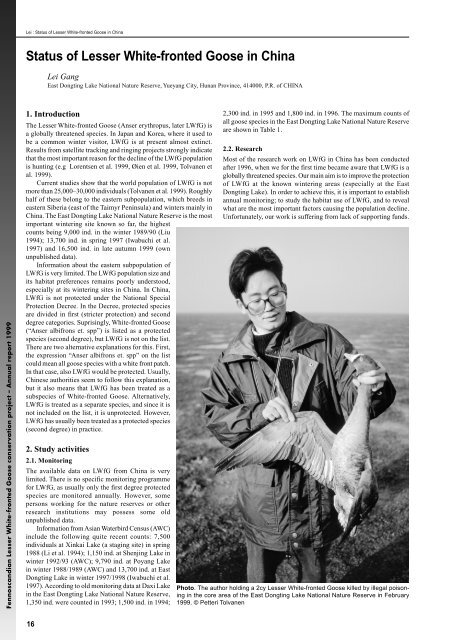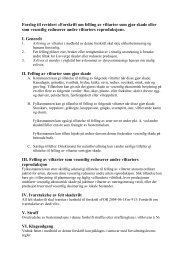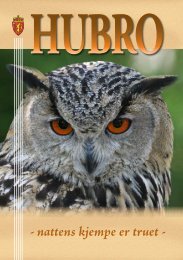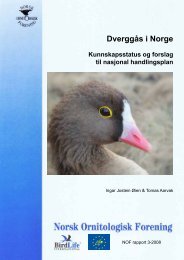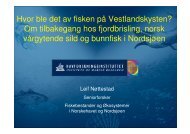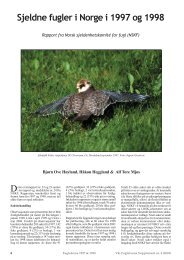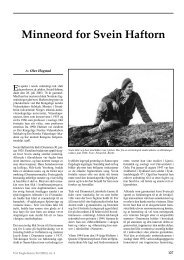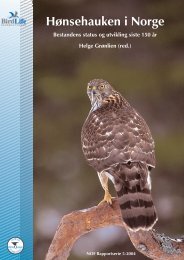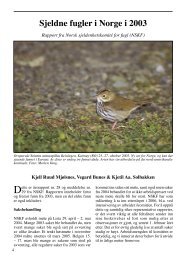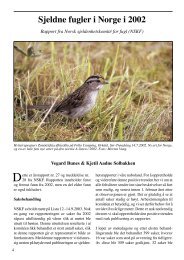Fennoscandian Lesser White-fronted Goose conservation project ...
Fennoscandian Lesser White-fronted Goose conservation project ...
Fennoscandian Lesser White-fronted Goose conservation project ...
You also want an ePaper? Increase the reach of your titles
YUMPU automatically turns print PDFs into web optimized ePapers that Google loves.
<strong>Fennoscandian</strong> <strong>Lesser</strong> <strong>White</strong>-<strong>fronted</strong> <strong>Goose</strong> <strong>conservation</strong> <strong>project</strong> – Annual report 1999<br />
Lei : Status of <strong>Lesser</strong> <strong>White</strong>-<strong>fronted</strong> <strong>Goose</strong> in China<br />
Status of <strong>Lesser</strong> <strong>White</strong>-<strong>fronted</strong> <strong>Goose</strong> in China<br />
16<br />
Lei Gang<br />
East Dongting Lake National Nature Reserve, Yueyang City, Hunan Province, 414000, P.R. of CHINA<br />
1. Introduction<br />
The <strong>Lesser</strong> <strong>White</strong>-<strong>fronted</strong> <strong>Goose</strong> (Anser erythropus, later LWfG) is<br />
a globally threatened species. In Japan and Korea, where it used to<br />
be a common winter visitor, LWfG is at present almost extinct.<br />
Results from satellite tracking and ringing <strong>project</strong>s strongly indicate<br />
that the most important reason for the decline of the LWfG population<br />
is hunting (e.g Lorentsen et al. 1999, Øien et al. 1999, Tolvanen et<br />
al. 1999).<br />
Current studies show that the world population of LWfG is not<br />
more than 25,000–30,000 individuals (Tolvanen et al. 1999). Roughly<br />
half of these belong to the eastern subpopulation, which breeds in<br />
eastern Siberia (east of the Taimyr Peninsula) and winters mainly in<br />
China. The East Dongting Lake National Nature Reserve is the most<br />
important wintering site known so far, the highest<br />
counts being 9,000 ind. in the winter 1989/90 (Liu<br />
1994); 13,700 ind. in spring 1997 (Iwabuchi et al.<br />
1997) and 16,500 ind. in late autumn 1999 (own<br />
unpublished data).<br />
Information about the eastern subpopulation of<br />
LWfG is very limited. The LWfG population size and<br />
its habitat preferences remains poorly understood,<br />
especially at its wintering sites in China. In China,<br />
LWfG is not protected under the National Special<br />
Protection Decree. In the Decree, protected species<br />
are divided in first (stricter protection) and second<br />
degree categories. Suprisingly, <strong>White</strong>-<strong>fronted</strong> <strong>Goose</strong><br />
(“Anser albifrons et. spp”) is listed as a protected<br />
species (second degree), but LWfG is not on the list.<br />
There are two alternative explanations for this. First,<br />
the expression “Anser albifrons et. spp” on the list<br />
could mean all goose species with a white front patch.<br />
In that case, also LWfG would be protected. Usually,<br />
Chinese authorities seem to follow this explanation,<br />
but it also means that LWfG has been treated as a<br />
subspecies of <strong>White</strong>-<strong>fronted</strong> <strong>Goose</strong>. Alternatively,<br />
LWfG is treated as a separate species, and since it is<br />
not included on the list, it is unprotected. However,<br />
LWfG has usually been treated as a protected species<br />
(second degree) in practice.<br />
2. Study activities<br />
2.1. Monitoring<br />
The available data on LWfG from China is very<br />
limited. There is no specific monitoring programme<br />
for LWfG, as usually only the first degree protected<br />
species are monitored annually. However, some<br />
persons working for the nature reserves or other<br />
research institutions may possess some old<br />
unpublished data.<br />
Information from Asian Waterbird Census (AWC)<br />
include the following quite recent counts: 7,500<br />
individuals at Xinkai Lake (a staging site) in spring<br />
1988 (Li et al. 1994); 1,150 ind. at Shenjing Lake in<br />
winter 1992/93 (AWC); 9,790 ind. at Poyang Lake<br />
in winter 1988/1989 (AWC) and 13,700 ind. at East<br />
Dongting Lake in winter 1997/1998 (Iwabuchi et al.<br />
1997). According to old monitoring data at Daxi Lake<br />
in the East Dongting Lake National Nature Reserve,<br />
1,350 ind. were counted in 1993; 1,500 ind. in 1994;<br />
2,300 ind. in 1995 and 1,800 ind. in 1996. The maximum counts of<br />
all goose species in the East Dongting Lake National Nature Reserve<br />
are shown in Table 1.<br />
2.2. Research<br />
Most of the research work on LWfG in China has been conducted<br />
after 1996, when we for the first time became aware that LWfG is a<br />
globally threatened species. Our main aim is to improve the protection<br />
of LWfG at the known wintering areas (especially at the East<br />
Dongting Lake). In order to achieve this, it is important to establish<br />
annual monitoring; to study the habitat use of LWfG, and to reveal<br />
what are the most important factors causing the population decline.<br />
Unfortunately, our work is suffering from lack of supporting funds.<br />
Photo. The author holding a 2cy <strong>Lesser</strong> <strong>White</strong>-<strong>fronted</strong> <strong>Goose</strong> killed by illegal poisoning<br />
in the core area of the East Dongting Lake National Nature Reserve in February<br />
1999. © Petteri Tolvanen


